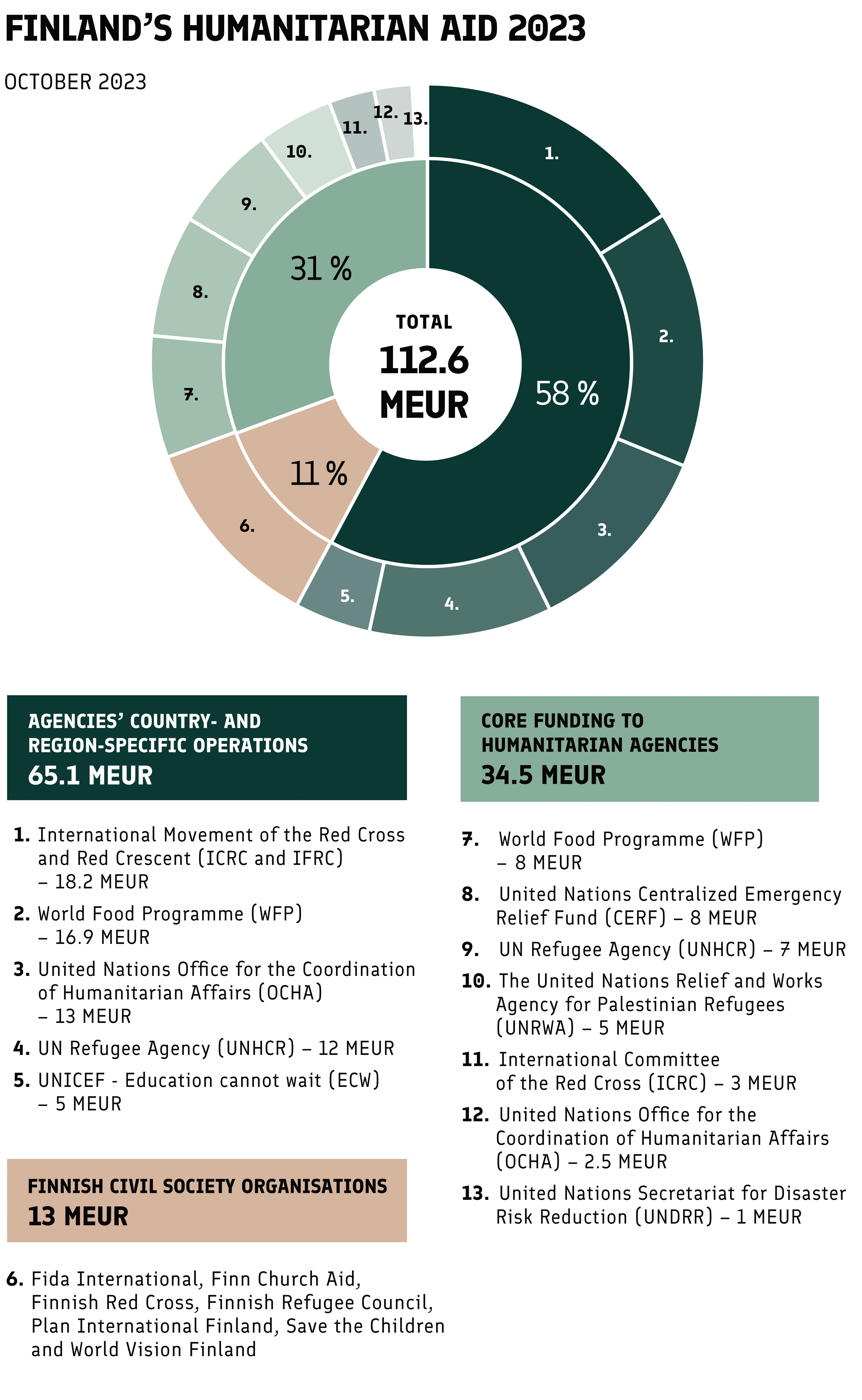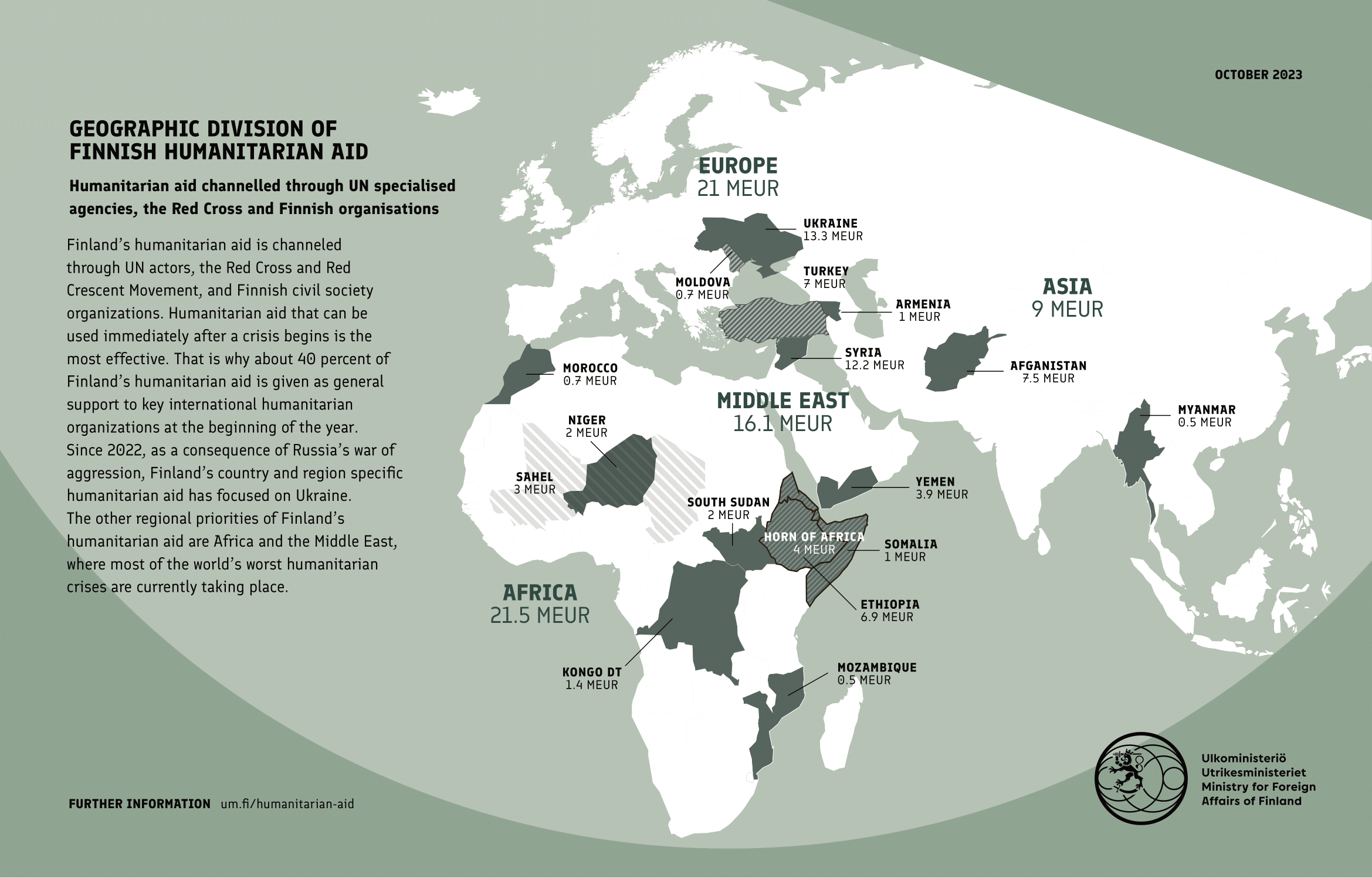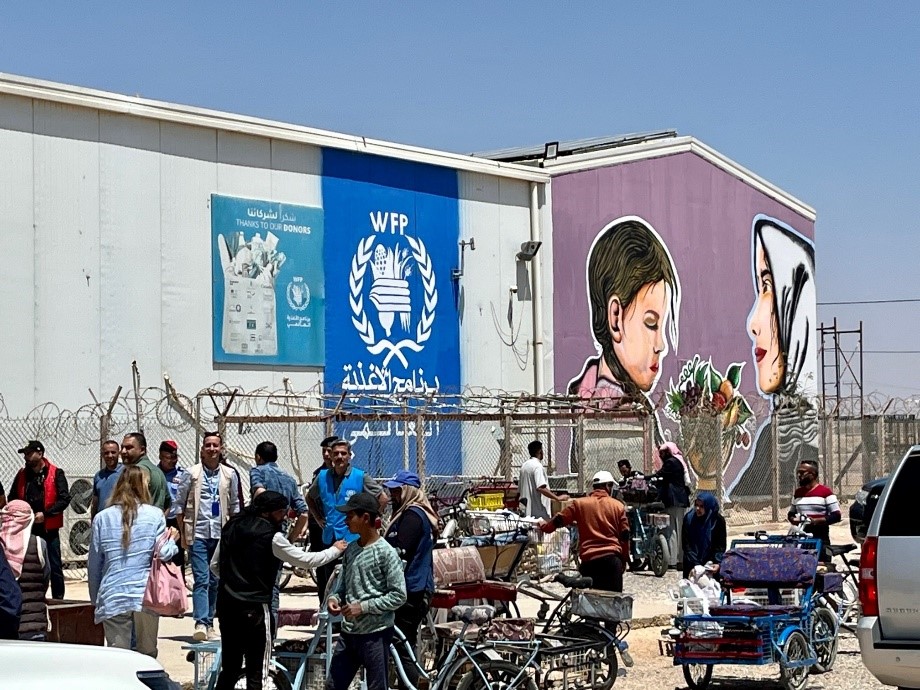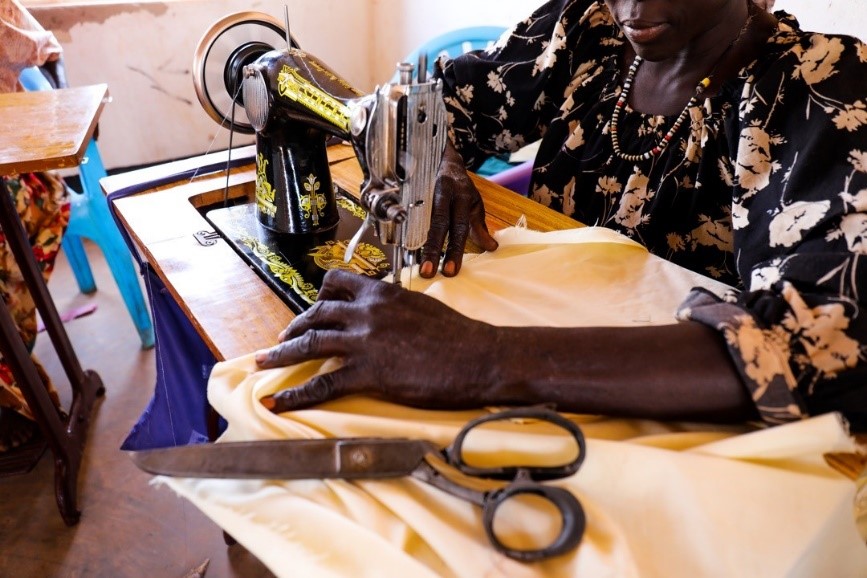Humanitarian aid brings relief in times of need
Every year, hundreds of millions of people suffer as the result of natural disasters, armed conflicts and other crises. Humanitarian aid saves human lives, relieves human suffering, and maintains human dignity in times of crisis. It is financed from Finland’s development cooperation appropriations.
Focusing aid where the need is greatest
The global need for humanitarian aid has more than doubled in just a few years. Russia’s aggression against Ukraine and other conflicts around the world have especially undermined global food security already weakened by the COVID-19 pandemic. More than 360 million people around the world are estimated to need humanitarian assistance and many are on the brink of famine. Climate change is expected to further aggravate the situation.
While the level of humanitarian funding has risen, the share of global humanitarian needs that are being addressed with the funding is getting smaller and smaller. That is why it has been necessary to deliver humanitarian aid only to the most vulnerable groups, and more and more people are not getting the help they need. As humanitarian needs grow, it has become increasingly difficult and dangerous to deliver help.
Finland’s humanitarian assistance is used to promote food security and support the protection of refugees in the world’s greatest humanitarian crises. Another important element of Finland’s food security efforts is the promotion of school meals globally. Finland’s assistance always focuses on assisting the most vulnerable people, especially persons with disabilities.
Finland’s budget for humanitarian assistance totals EUR 121 million in 2023.

- Finland's humanitarian aid in 2022
- Finland's humanitarian aid in 2021
- Finland's humanitarian aid in 2020 (PDF, 76 KB)
- Finland's humanitarian aid in 2019 (PDF, 73 KB)
- Finland's humanitarian aid in 2018 (PDF, 587 KB)(Link to another website.)
Finland’s decisions on humanitarian assistance are always based on UN-coordinated global humanitarian needs analyses, on our partners’ appeals for funding and on project applications by Finnish civil society organisations.
Finland is committed to channelling annually about 10 per cent of its development aid appropriations for humanitarian aid. However, in recent years this share has been nearly 15 per cent. Finnish aid is directed to countries that receive official development assistance (ODA).

Geographic division of Finnish humanitarian aid – the situation in February 2021 (PDF, 720 KB)
Geographic division of Finnish humanitarian aid – the situation in March 2020 (PDF, 558 KB)
Geographic division of Finnish humanitarian aid – the situation in March 2019 (PDF, 551 KB)
Finland’s humanitarian assistance is channelled through UN specialised agencies, the International Red Cross and Red Crescent Movement and Finnish civil society organisations. The most effective humanitarian aid is available on site when a crisis hits. That is why around 40 per cent of Finland’s humanitarian assistance consists of core funding to key international humanitarian organisations, granted at the start of each year. Finland also delivers humanitarian assistance directly to countries and regions. The focus of this assistance has been on Ukraine after Russia started its war in 2022. Other priority areas of Finland’s humanitarian assistance are in Africa and the Middle East, where most of the world’s humanitarian crises are occurring at the moment.
Read more about international humanitarian aid:
- United Nations Office for the Coordination of Humanitarian Affairs OCHA(Link to another website.)
- European Civil Protection and Humanitarian Aid Operations ECHO(Link to another website.)
- Humanitarian information portal Relief Web(Link to another website.)
- Disaster risk reduction website Prevention Web(Link to another website.)
- The New Humanitarian(Link to another website.) – reporting on humanitarian crises
Organisations bring emergency relief where it is needed
It is important for Finland that the organisations it supports operate openly, responsibly, effectively and impartially. The organisations delivering aid must have sufficient authority to operate in crisis-affected areas and the ability to bring aid where it is needed in an emergency.
The Finnish Ministry for Foreign Affairs channels its funds for humanitarian aid through UN bodies, the International Committee of the Red Cross and Finnish aid organisations.
Of the UN agencies, Finland supports the United Nations Office for the Coordination of Humanitarian Affairs (OCHA), the Office of the United Nations High Commissioner for Refugees (UNHCR), the United Nations Relief and Works Agency for Palestine Refugees in the Near East (UNRWA), the World Food Programme (WFP), United Nations Office for Disaster Risk Reduction (UNDRR), and the United Nations Central Emergency Response Fund (CERF). Aid to the Red Cross and Red Crescent movement is channelled through the International Committee of the Red Cross (ICRC) and the International Federation of Red Cross and Red Crescent Societies (IFRC).

These organisations are engaged in concrete aid work in crisis locations: distributing food aid, urgent healthcare, clean water and emergency shelters, preventing gender-based violence, and improving the healthcare, water supply and sanitation in refugee camps. Creating proper conditions for livelihoods speeds up recovery from a crisis and prepares the ground for reconstruction and the return of refugees and those who have fled their homes.
Finnish civil society organisations (CSOs) carry out valuable work in the education sector, in child protection and in promoting the inclusion of persons with disabilities. Around 10 per cent of Finland’s humanitarian assistance is reserved annually for humanitarian projects of Finnish CSOs. In Finland, organisations that have signed a framework partnership agreement with the European Commission’s Civil Protection and Humanitarian Aid Operations Department (ECHO) are eligible for humanitarian aid financing. These organisations include Fida International, Finn Church Aid (FCA), Finnish Refugee Council, Save the Children Finland, Plan International Finland, Finnish Red Cross and World Vision Finland.
Protecting the civilian population is an essential part of aid in conflict and unrest. Finland emphasises the importance of considering the needs and rights of vulnerable people, such as persons with disabilities. Another group in need of special support is women and girls, who may be subjected to sexual violence as a weapon of war. Children, too, need special protection when disasters strike, since they are at risk of being separated from their families and they may be subjected to violence and abuse or be recruited as child soldiers.

Assistance must be impartial
Finnish humanitarian action is grounded on international humanitarian law, international human rights treaties, refugee law, and the principles endorsed by the UN. Finland is committed to adhering to the principles of Good Humanitarian Donorship and the Grand Bargain initiative.
Internationally agreed practices highlight humanitarian principles, which are humanity, impartiality, neutrality, and independence. Aid is to be provided solely based on identified needs, and not for political, military or economic reasons.
The principles guiding Finnish action are defined in Finland’s Humanitarian Policy, the Guideline Concerning Humanitarian Assistance and the Use of Funding, and the European Consensus on Humanitarian Aid.
It is important for Finland that humanitarian action focus on vulnerable groups – especially girls, women and persons with disabilities – as well as environmental effects, the promotion of gender equality and the reduction of inequality.
- Finland's Humanitarian Policy (2019) (in Finnish, PDF, 2 327 KB)
- Guideline Concerning Humanitarian Assistance and the Use of Funding - Application Instructions for Finnish CSOs (2019) (in Finnish, PDF, 669 KB)
- Good Humanitarian Donorship (GHD)(Link to another website.)
- The European Consensus on Humanitarian Aid(Link to another website.)
Finland supports greater inclusion of persons with disabilities
Finland has an international lead role in promoting the rights of persons with disabilities, and we have improved the ways their needs are considered during conflicts and disasters. In 2019, Finland decided that one of its key humanitarian priorities is to focus on the needs of persons with disabilities during humanitarian crises.
While on average persons with disabilities account for around 16 per cent of the global population, their share is much higher in conflict-affected areas. In humanitarian crises, persons with disabilities are more likely than other population groups to not receive the emergency relief and protection they need and they are often excluded from the planning and delivery of aid. Especially girls and women with disabilities are at a high risk of being subjected to sexual violence, abuse and multiple discrimination.
Finland advocates internationally to urge large humanitarian actors, such as UN specialised agencies, to mainstream disability inclusion into their strategies and country-level operations. Finland’s long-term efforts to promote the rights of persons with disabilities has contributed to a systemic change currently underway in the UN. In its advocacy work, Finland collaborates closely with disability organisations and partner countries. At the moment, Finland is co-chairing together with Australia and the United Kingdom a group of countries promoting disability inclusion. Finnish civil society organisations, too, are paying particular attention to the needs of persons with disabilities and doing valuable work in their projects to promote the rights of persons with disabilities.
Brochure: Vulnerable people in humanitarian crises (PDF, 147 KB, in Finnish)(Link to another website.)
School meals support learning
The Global School Meals Coalition, founded in 2021 at the initiative of Finland and the World Food Programme (WFP), promotes access to school meals and the funding for them across the world, including in crises. One of the Coalition’s aims is to guarantee all children in the world access to school meals by 2030. More than 70 countries and 70 other entities have joined the Coalition. It is co-chaired by Finland, France and Brazil.
Finland as an active player in humanitarian assistance
Finland actively participates in humanitarian aid cooperation at EU level and within the international donor community as well as in the executive boards of the agencies and organisations it finances. Finland and Belgium co-chaired the Good Humanitarian Donorship (GHD) initiative in 2021–2023. The GHD upholds the principles of humanitarian assistance and strives to find best practices for effective donor policies. In the EU, the key channel of influence is the Working Party on Humanitarian Aid and Food Aid (COHAFA).
Finland emphasises the leading role of the UN in aid coordination and supports the UN’s ongoing humanitarian aid reform whose goal is to create an efficient and well-coordinated international humanitarian aid system.
Active involvement in donor coordination and executive boards alongside monitoring visits to crisis-affected countries and dialogues with the secretariats are important parts of the monitoring and supervision of Finland’s humanitarian aid.
From humanitarian aid to development cooperation
When a crisis-torn country or region is returning to normalcy, it faces many challenges. For Finland, it is important that crisis prevention, humanitarian assistance, peacebuilding, reconstruction, and development cooperation be flexibly combined. These different phases are part of a continuum; they support each other and help people overcome the crisis.
In February 2019, the OECD Development Assistance Committee (DAC) adopted a recommendation known as the triple nexus (Recommendation on the Humanitarian-Development-Peace Nexus) with the aim to strengthen the effectiveness of humanitarian aid, development cooperation and peacebuilding. Its objective is to create a mutually complementary package of policies, operations and actors in the fields of humanitarian aid, development cooperation and peacebuilding. To support the implementation of the triple nexus approach the Ministry for Foreign Affairs issued a guidance note ‘The triple nexus and cooperation with fragile states and regions’ in 2022. The purpose of the guidance note is to strengthen cooperation between humanitarian aid, development cooperation and peacebuilding and to make their efforts more coherent, complementary and effective.
It is essential to strengthen the coherence, complementarity and effectiveness of humanitarian aid, development cooperation and peacebuilding and to encourage stronger mutual cooperation among different actors. In this way, we will be more effective in reaching people who need help in different kinds of situations and in preventing crises and conflicts, building peace and strengthening the resilience of States and communities.
The OECD DAC Recommendation on the Humanitarian-Development-Peace Nexus is binding on all OECD DAC members. Its implementation will be assessed through peer reviews of DAC member states. The recommendation is based on the 2030 Agenda for Sustainable Development. Finland is committed to advancing the 2030 Agenda together with all UN member states. Measures to prevent disaster risk, limit damage and improve the capacities of governments and organisations to act in emergencies are also considered important.


